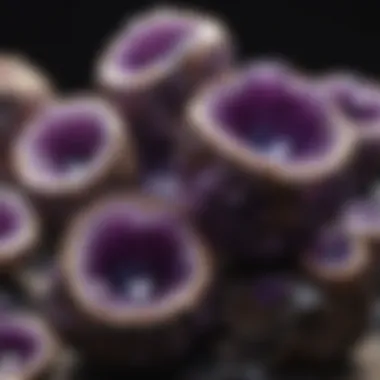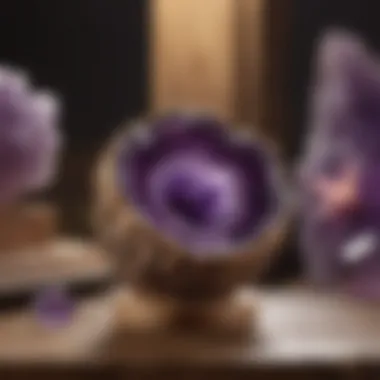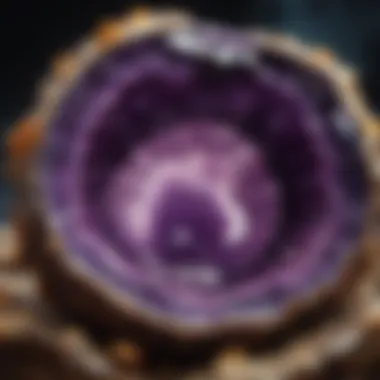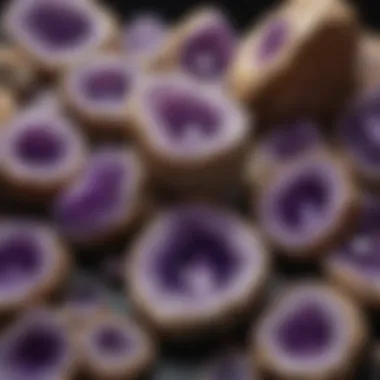The Comprehensive Guide to Buying Amethyst Geodes


Intro
Purchasing amethyst geodes can feel like stepping into a vibrant world filled with centuries of natural artistry. These stunning formations, characterized by their sparkling purple crystals, hold a deep attraction for collectors and enthusiasts alike. As interest in rock collecting has grown, so has the market for these beautiful specimens. Yet, buying the right geode, especially amidst a plethora of options, requires a discerning eye and a bit of knowledge.
It’s not merely about owning a piece of nature; it's also about appreciation for craftsmanship, geological wonder, and investment potential. In this guide, you'll embark on a journey through various sources where these geodes can be found, the essential characteristics to consider before purchase, and tips on how to care for your prized gems.
Topic Overview
Definition of the collectible
Amethyst geodes are hollow rock formations that are lined with quartz crystals, specifically the purple variety of quartz known as amethyst. These geodes form over thousands of years through a combination of volcanic activity and mineral deposition. They're not only aesthetically pleasing but also hold various meanings in different cultures, often associated with healing and tranquility.
Brief history and significance
The history of amethyst is as rich as its color. In ancient times, amethyst was considered a precious stone, often linked to royalty. Greeks wore amethyst to avoid intoxication, while soldiers believed it to confer courage. Today, collectors embrace amethyst geodes for their beauty and rarity. They are a centerpiece in many rock collections and serve as an insight into the Earth’s geological processes.
Identification and Classification
How to categorize items
Understanding how to classify amethyst geodes is key to a knowledgeable purchase. Generally, they can be categorized based on:
- Size: From small pocket pieces to large display specimens.
- Quality: Characterized by the clarity and saturation of color in the amethyst crystals.
- Shape: Some geodes have a simple oval shape, while others may have more complex formations.
- Origin: Locations such as Brazil, Uruguay, and South Africa are renowned for high-quality amethyst.
Tips for identifying key features
When on the hunt for the perfect geode, keep an eye out for several key features:
- Crystal Quality: Inspect the crystals for clarity and distinctiveness; top-quality amethyst should exhibit a deep purple hue with minimal inclusions.
- Surface Condition: Cracked or chipped surfaces can indicate poor handling or lack of care.
- Geode Size: Depending on your interests and budget, the size of the geode will play a significant role in its value and visual impact.
- Unique Characteristics: Some geodes may have unique inclusions or unusual shapes that set them apart.
"When selecting an amethyst geode, trust your instincts–a stone's energy can speak to its beholder."
Understanding these aspects will provide you with a solid foundation as you navigate the market for amethyst geodes. As we move forward, you will find a range of options on where to buy, factors influencing price, and tips on maintaining your collection, fortifying your knowledge as a savvy collector.
Prologue to Amethyst Geodes
Amethyst geodes captivate many of us, with their rich purple hues and unique formations. They are not just eye-catching decorations; they carry a wealth of history and scientific intrigue. When diving into the world of amethyst geodes, understanding what they are, where they come from, and their cultural significance enhances the buying experience immensely. This foundational knowledge prepares both novice and seasoned collectors for making well-informed choices.
Understanding Amethyst Geodes
Amethyst geodes are essentially hollow rocks lined with amethyst crystals and other minerals. They usually form in volcanic rocks, where gas bubbles create a cavity. Over time, mineral-rich water seeps into these hollow spaces and, as it evaporates, leaves behind stunning crystals. The allure of amethyst comes from its deep violet color, a result of iron content and natural radiation affecting the quartz structure.
Collectors need to know that while all amethyst geodes are beautiful, they are also quite diverse. Some may display clusters of tightly packed crystals, while others have larger, more separated ones. Each geode tells its own story, reflecting not just geological forces but also the artistry of nature itself. So when considering a purchase, remember, it's not just about buying a rock; you are acquiring a piece of earth's history and artistry.
Historical Significance
The historical significance of amethyst cannot be overlooked. In ancient times, this gemstone was highly esteemed, often associated with royalty and spiritual enlightenment. People believed amethyst could prevent intoxication, leading to its common use in chalices and drinking vessels during the Middle Ages.


Beyond its regal connections, amethyst has also been tied to various cultures worldwide. For instance, the Egyptians revered amethyst, using it in jewelry and burial artifacts. In modern spirituality, it's often linked to meditation and healing practices. Knowing this background not only adds depth to your geode but also an interesting narrative to share with fellow collectors.
"Owning an amethyst geode is like holding a bit of history in your hands. It's not just a beautiful piece; it's a reminder of the earth's transformative processes and humankind's longstanding relationship with these natural wonders."
Market Overview
The market for amethyst geodes has evolved over the years, becoming a vibrant sector within the broader collectibles community. It’s not just about acquiring beautiful pieces; it’s an investment, a passion, and for some, a lifestyle. Understanding the nuances of this market equips potential buyers with the knowledge to make informed selections, whether they're seasoned collectors or beginners just dipping their toes into the exciting world of geodes.
When considering the market for amethyst geodes, several factors come into play. Prices fluctuate based on demand, the quality of the geodes, and, increasingly, sourcing practices. As awareness of ethical sourcing grows, buyers are becoming more selective, valuing transparency regarding the origins of these striking specimens.
In terms of benefits, having a engaged understanding of the market allows buyers to identify quality pieces without falling prey to marked-up prices due to trends or fads. Geode collecting is often influenced by seasonal trends. For instance, certain times of the year see lower prices as new collections come out, while other times may see prices spike, especially if a specific trend catches wind in the community. Noting these cycles can enhance a collector's experience.
Additionally, geographic considerations significantly influence both supply and pricing. Some regions are known hotspots for high-quality amethyst geodes, and this local prominence can drive prices up. Whether it's a pristine specimen found in a lesser-known area, or a well-established offering from a reputable source, knowing where to look is half the battle.
Ultimately, gaining a grasp of the market not only aids in smart purchasing decisions but also enriches the overall collecting experience. It transforms what can often feel like an overwhelming endeavor into something manageable, even enjoyable.
Current Trends in Geode Collecting
In the ever-changing landscape of geode collecting, trends come and go, but a few current movements have captured the attention of enthusiasts.
- Sustainable Sourcing: Many collectors are now leaning towards ethically sourced geodes. This means considering not just the beauty and rarity of the geode but also the environmental and social impacts of its extraction. Collectors value sellers who can provide information on their sourcing practices.
- The Rise of Home Decor: Amethyst geodes have found their way into the home decor sphere. More homeowners and interior designers are using these stunning rocks as statement pieces, making them increasingly popular outside traditional collecting circles.
- Interactive Collecting: It's not just about static displays anymore. Many collectors are looking for ways to engage with their pieces, such as through educational kits that teach aspects of geology and mineralogy. This trend invites a younger audience into the fold, making collecting more interactive and educational.
Keeping an eye on these trends can not only keep collectors informed but also help them make wise choices in terms of purchasing and displaying their collections.
Popular Locations for Sourcing Amethyst
Finding quality amethyst geodes can be a treasure hunt, but some areas are particularly known for their rich offerings.
- Brazil: Renowned for its stunning amethyst druse, Brazil is often the first stop for serious collectors. The clusters of vibrant purple hues found within are both striking and sought after.
- Uruguay: Similar to Brazil, Uruguay has become a hotspot for collectors seeking high-grade amethyst geodes. The geodes here are known for their exceptional color and clarity, often fetching high prices at auctions.
- Arizona, USA: Closer to home for many North American collectors, Arizona has a reputation for producing both large geode specimens and smaller, beautifully polished pieces that make excellent decorative options.
- Mexico: The diversity of minerals in Mexico contributes to a unique collection experience. While known for its opals, Mexico also offers great finds in amethyst geodes, often at varied price points depending on quality.
"Location can significantly influence not only the type but also the quality and value of amethyst geodes. Knowing where to source these beauties can save collectors both time and money."
As the market continues to evolve, remaining informed about where to find amethyst geodes can prove essential to ensuring that both newcomers and experienced collectors can build and refine their collections with confidence.
Where to Buy Amethyst Geodes
Finding the right place to purchase amethyst geodes is a pivotal step for both budding enthusiasts and seasoned collectors alike. The location not only dictates the varieties that are available but can also influence the pricing and authenticity of the geodes. Here’s a closer look at the various options and what benefits each brings to the table.
Local Rock Shops and Geology Stores
Shopping at local rock shops and geology stores can offer a unique experience compared to online purchases. These establishments often carry a curated selection of geodes, featuring pieces that are locally sourced or handpicked by knowledgeable staff. Visiting a shop in person allows you to get up close and personal with the geodes, examining their appearance, size, and quality firsthand.
When visiting these stores, consider the following:
- Knowledgeable Staff: Often, staff members are passionate about geology and can provide valuable insights or guidance based on your interests.
- Local Sourcing: Many rock shops focus on regional specimens, offering a chance to own a piece of local geology.
- Community Engagement: These shops often host events or workshops, perfect for those looking to expand their knowledge.
In summary, local rock shops serve as a fantastic starting point for both exploration and education, allowing buyers to touch and feel the stones before making a decision.
Specialty Online Retailers


The internet has opened up a whole new world for collectors. Specialty online retailers often provide access to rare and high-quality amethyst geodes that traditional stores may not carry. These retailers specialize in selling crystals and minerals, ensuring a wide variety and often superior quality.
Here’s what you should keep in mind:
- Quality Assurance: Specialty retailers usually provide detailed descriptions and photographs, helping you gauge the quality and authenticity of each piece.
- Variety: From smaller pocket pieces to larger display geodes, you can find virtually anything.
- Convenience: Shopping online allows you to easily compare prices and products without the hassle of travel.
For serious collectors seeking unique forms, specialized online sellers can often provide the best selection.
Major Online Marketplaces
In contrast to specialty retailers, major online marketplaces like eBay or Amazon are worth exploring for amethyst geodes. These platforms offer an extensive array of options, often at competitive prices. However, they come with their own set of challenges: .
- Varying Quality: The quality of listings can fluctuate dramatically, so it’s essential to do your research on both the product and the seller.
- Customer Reviews: Reviews can be quite telling. Look for sellers with established ratings and positive feedback to avoid scams.
- Comparison Shopping: Because these marketplaces are vast, you can quickly compare prices and find the best deal on a specific type of geode.
In sum, while major online marketplaces provide ample choices, the onus is on the buyer to ensure they are sourcing quality products from reputable sellers.
Evaluating Quality and Authenticity
When it comes to purchasing amethyst geodes, understanding the quality and authenticity of the stone becomes indispensable. Rather than solely relying on charm or aesthetics, a true collector must delve deeper into the attributes that signify genuine amethyst. This ensures that you are not merely buying a pretty rock, but something that holds value over time—both emotionally and financially.
When evaluating a geode, consider factors such as color, clarity, and size. Each of these elements contributes not just to the overall appearance but also to the intrinsic value of the gemstone. Buying without this knowledge can lead to regrets later, especially if you’ve invested considerable money into a geode that doesn’t measure up. With authenticity as a cornerstone of any purchase, it’s vital to equip yourself with the right knowledge as you navigate your options.
"The difference between a stunning find and a disappointing dud often comes down to knowing what to look for."
Identifying Genuine Amethyst
Identifying genuine amethyst can be a bit like distinguishing fine wine—you need to develop a discerning palate. The first thing to factor in is color. Authentic amethyst should exhibit a rich or deep purple hue, often with a varying intensity. That’s not a flat shade, though; think gradients, where lighter lavender might flirt with darker royal tones in the same piece.
Another consideration is clarity. Flaws naturally happen, but a genuine amethyst will have a certain translucence. If a geode appears completely opaque or has an unnatural sheen, that’s a red flag. Additionally, look for natural inclusions. These can act as fingerprints, marking the authenticity of the stone. Free from imperfections usually indicates a synthetic origin rather than a naturally occurring delight. The character found in natural imperfections often enhances visual interest.
Physical Characteristics of Quality Geodes
When assessing the physical characteristics of quality geodes, several aspects command attention. First in line is size and weight. Generally speaking, heftier geodes often symbolize richer crystalline content. A well-formed geode should feel substantial in hand—not flimsy or hollow.
Next up is the exterior. The texture of the outer layer should not be overlooked. A high-quality geode’s outer shell is usually rugged, exhibiting natural patterns from the surrounding rock. This is a notable indicator that the geode is unaltered and, hence, potentially more valuable.
Inside the geode, the structure of the amethyst crystals also deserves inspection. Look for pointy, well-formed crystals that reflect light beautifully. The arrangement of these crystals can tell you a lot—better geodes will have a crystal formation that approaches the center while common ones may seem sparse or poorly organized.
In addition to these factors, clarity among the crystals is essential. Just as with identifying genuine amethyst, visible clarity can elevate the perceived quality of the geode. The more transparent and shimmering it is, the more appealing (and pricier) it becomes.
Incorporating this knowledge will not only add to your collection but also empower you as a discerning buyer. Armed with these pointers, you will tread these rocky paths with confidence, making informed decisions that resonate with your collection goals.
Pricing Considerations
Understanding the pricing of amethyst geodes is pivotal for anyone venturing into this engaging arena. Prices can vary widely based on several factors, and being armed with knowledge can make a world of difference. For a collector, whether novice or seasoned, comprehending the ins and outs of geode pricing offers benefits beyond mere acquisition. It helps in identifying fair deals and makes for a more rewarding collecting experience.
Factors Influencing Price


When determining the price of amethyst geodes, several elements come into play. Here are the key price influencers:
- Size: Larger geodes, naturally, command higher prices. A smaller geode might cost just a fraction of a substantial one, perhaps several times bigger.
- Quality: This includes clarity, color saturation, the presence of additional minerals, and the overall aesthetic appeal. A deeply colored amethyst geode will typically fetch a higher price.
- Origin: The geographical source can also drive up prices. For example, geodes originating from Brazil or Uruguay are often sought after for their unique characteristics and can be priced accordingly.
- Rarity: Unique formations or particularly beautiful crystals can make some geodes much more valuable. Finding a geode with a distinctive feature might cost considerably more.
- Market Demand: Trends can fluctuate based on popularity among collectors. For instance, if a particular style or type gains traction, its price can rise.
Understanding these factors equips buyers to navigate the market effectively. As prices fluctuate based on these elements, being informed aids collectors in making judicious decisions.
Typical Price Ranges
The price for amethyst geodes can be a mixed bag, depending on the aforementioned influences. Here’s a breakdown to give you a clearer idea:
- Small Geodes (3-5 inches): These typically range from $20 to $50. Great for beginners just wanting a taste of collecting.
- Medium Geodes (5-10 inches): Expect to pay about $50 to $150. They offer more substantial beauty and depth.
- Large Geodes (10-20 inches): Prices usually fall between $150 to $500. They often become the focal point in collections due to their impressive size and aesthetic appeal.
- Extra-Large Geodes (20+ inches): These can be significantly more expensive, commonly starting at around $500 and going up to several thousand dollars, depending on quality and unique characteristics.
"Knowledge is power, especially when it comes to navigating the rocky terrain of crystal collecting."
By grasping the pricing considerations, you can be sure you're not just buying a rock, but a piece of nature's artistry.
Care and Maintenance of Amethyst Geodes
Amethyst geodes can be a striking addition to any collection, but they also require a certain level of care and maintenance to ensure their beauty and integrity lasts over time. Proper attention to these shimmering stones makes a world of difference — not just for aesthetics but for preserving value and avoiding damage. With the right practices, you can maintain their allure, enhancing your enjoyment as a collector.
Cleaning Techniques
Keeping your amethyst geodes clean is crucial for maintaining their vibrant appearance. Dust and grime can accumulate, dulling the natural shine and obscuring the deep hues of the crystals. Here are some techniques to consider:
- Gentle Dusting: Use a soft, dry microfiber cloth to remove surface dust. This simple act should be part of your regular routine.
- Water and Soap Mixture: For deeper cleaning, mix a small amount of mild soap with lukewarm water. Dip a cloth in this solution, wring it out well, and gently wipe the geode’s surface. Be careful to avoid excess moisture, as water trapped in the hollow space can damage the crystals.
- Avoid Harsh Chemicals: Stay away from strong detergents, bleach, or acidic cleaners — these can stain or etch the surface of your geode, ruining its finish.
- Dry Thoroughly: After cleaning, ensure the geode is completely dry to prevent issues like mold or mineral growth inside the cavity.
Remember, less is often more. Regular gentle cleaning is better than infrequent heavy scrubbing.
Display Considerations
How you choose to display your amethyst geodes can also influence their longevity and beauty. There are various strategies to ensure they catch the eye while remaining well-kept:
- Indirect Light: Place your geodes away from direct sunlight, which can fade colors over time. A well-lit area with indirect light works best to showcase their sparkling beauty without causing damage.
- Stable Environment: Avoid placing them in areas with drastic temperature changes or high humidity, as these conditions can negatively affect the geode. A stable, climate-controlled environment helps prevent cracking or other issues.
- Support Base: When displaying geodes, ensure they are on a solid, supportive base to prevent accidental falls. Consider using decorative pedestals or displays that keep them secure yet visible.
- Use Protective Cases: For especially valuable pieces, consider a display case with UV protection. An enclosed case not only protects from dust but can also provide a layer of aesthetic appeal.
With these practices in mind, fit your cleaning and display methods to your personal preferences and environmental conditions. By treating your amethyst geodes with care and respect, you not only maintain their beauty but also keep your collection unique and valuable.
End and Final Thoughts
In this journey through the vibrant world of amethyst geodes, we've uncovered pearls of wisdom essential for both budding enthusiasts and seasoned collectors. Understanding the intricacies of choosing the right geode is not just about aesthetics or price—it encompasses recognition of quality, craftsmanship, and the stories behind each piece. As we wrap up, it’s clear that knowledge is power, especially in a market that thrives on authenticity and a discerning eye.
The importance of navigating the nuances of amethyst geodes cannot be overstated. With various sources available, it is crucial to identify reputable sellers and distinguish genuine products from imitations. This not only protects your investment but also enriches your collection with pieces of true value. From the depth of color to the structural integrity, attention to detail plays a pivotal role in making informed purchasing decisions.
Moreover, it’s easy to overlook the maintenance aspect when one’s eyes are set on the dazzling beauty. Proper care ensures the longevity of your geodes, preserving both their lustrous appeal and their historical significance. Incorporating simple cleaning techniques and thoughtful display methods will allow each stone to shine in its own right, making your collection a source of pride.
In essence, the act of acquiring amethyst geodes transcends mere purchasing. It invites a journey—one that encourages exploration, education, and an appreciation for nature’s artistry. Dive deeper, seek knowledge, and elevate your understanding of these stunning geological wonders.
Summary of Key Points
- Understand the distinction between authentic and imitation geodes to make wise purchases.
- Evaluate quality based on color saturation, clarity, and overall aesthetics.
- Explore various marketplaces like local shops, specialty retailers, and online platforms to find the best selections.
- Maintain your geodes with appropriate cleaning practices and consider how to display them thoughtfully.
- Be aware of current trends in collecting to engage with the community and discover new sources.
Encouragement for Knowledge Expansion
The realm of amethyst geodes is vast and ever-evolving, making it ripe for exploration. Branching out into new facets of geological study can enhance not only your collection but also your understanding of the earth's history. Engage with community forums, attend geology clubs, and join discussions on platforms like Reddit or Facebook to connect with like-minded collectors.
Reading books, subscribing to geology magazines, or following relevant online resources can provide deeper insights and broaden your perspective. Remember, knowledge isn't just a box to tick off; it's a continuous journey that enriches your appreciation for these natural wonders. So, pull up a chair, grab a cup of coffee, and dig into the delightful world of geodes—there's always more to learn!



